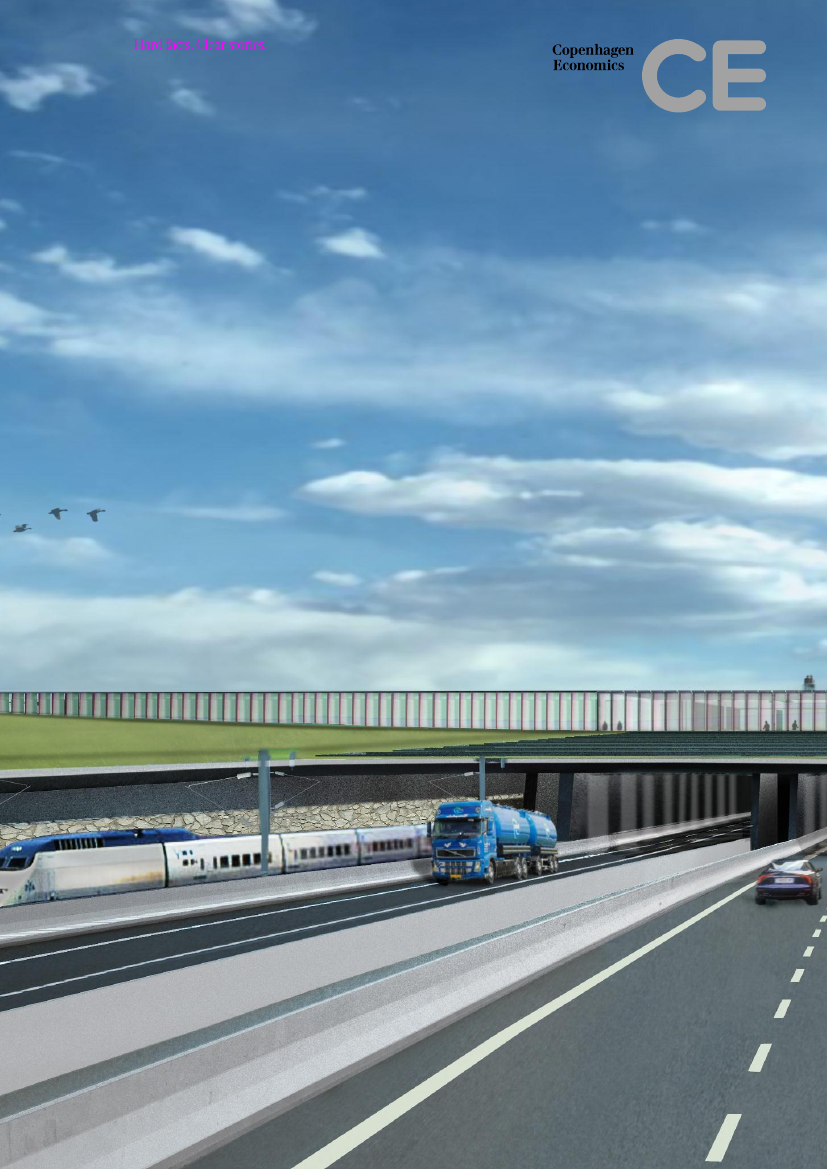Transportudvalget 2013-14
TRU Alm.del
Offentligt
Technical notefor input-outputanalysisDocumentation for the economic-wideemployment impact of the Femern Belttunnel construction
Copenhagen EconomicsJune 2013
Documentation for the economic-wideemployment impact of the Femern Belttunnel construction
PrefaceThis is a technical note about the Input-Output model (IO) used to assess the economy-wide employment impact of Femern Belt fixed link (tunnel) construction. It describesthe IO methodology as well as data sources used. Section 1 provides a general descrip-tion of the input-output analysis. Section 2 explains the two steps that we follow tointegrate project budget into an IO table. Section 3 deals with data that has been usedas an input in the IO analysis.
1 Introduction to input-output analysis"Input-outputanalysis describes the analytical approach developed by ProfessorWassily Leontief in the late 1930s - for which he was awarded the Nobel Prize in eco-nomics in 1973. The Input-output analysis' main purpose is to analyse the interde-pendence of industries in an economy and is one of the most used methods in econom-ics."1The basis of an input-output analysis is the so-called input-output table. The table ineach row shows how goods and services are sold to different sectors and final consum-ers; while in each column it describes how goods and services are purchased from dif-ferent sectors, wages and salaries paid etc.The indirect impact of industry X is calculated by estimating the value added of its sub-suppliers, which is attributed by the industry X ‘s input consumption. Multiplier arecalculated to capture that when the sub-suppliers again purchase goods and servicesfrom others sub-suppliers, this tells us how much industry X is contributing to the val-ue added created by its suppliers.Induced impact of industry X is calculated by quantifying the value added generatedthough its employees’ spending (i.e. through spending the wages and salaries paid outby industry X). This induced impact exists due to the fact that the wages and salarieswill be spent in an economy, which will further generate additional value added in dif-ferent sectors.Using the same principles as above, the impact in terms of employment is calculated byusing wage per employee in each sector.The total employment contribution of an industry (direct + indirect+ induced), can becompressed into three multipliers which tell us how big the total contribution is rela-
1
Taken from introduction section of the book entitled as “Input-output Analysis- Foundations and Extensions”,Second Edition, R.E. Miller og P.D Blair, 2009
2
Documentation for the economic-wideemployment impact of the Femern Belttunnel construction
tive to the value of production in the industry. Such standard multipliers can be calcu-lated on the basis of the input-output table.2In general, the total contribution (direct + indirect+ induced) of an industry, inter alia,depends on its share of input purchases from domestic sectors versus imports, and theamount of its primary factor payments. For example, the higher the share of purchasesfrom domestic suppliers the higher the total contribution (through indirect effects willbe and vice versa. Hence, before analysing economic impact of a given industry usingIO model, a precise distribution of its revenue into purchases of goods and serviceacross sectors and remuneration of primary factors is a very essential exercise.The next section explains how the total construction budget for the Femern Belt projecthas been dealt with in the input-output analysis.
2 Integrating Femern A/S into the Danish IO tableSo as to calculate the three multipliers (direct + indirect+ induced), the Femern Beltconstruction has to be integrated into the most current Danish IO table. We distributedFemern’s total projected budget for the construction of the tunnel as well as its distri-bution into purchases of goods and services and payment of primary factors.The total construction budget is projected to be DKK 43.9 billion in 2011 prices and 77per cent of which is assumed to be spent on Danish economy and the rest to be spenton German and other countries economy, cf. Table 1.
Table 1 Femern A/S’ construction budget spendingConstruction budget spendingDanish economyGerman economyOther countries economyTotal budgetNote:Construction budget, bill. dkk in2011* price33.86.63.543.9Share of total budget77%15%8%100%
*The construction period is between 2015-2021, and hence we use internal discount factor of(2.56%) from Femern A/S investment plan to calculate the total budget in 2011 price.
Source: Femern A/S "Vurderinger af de beskæftigelsesmæssige effekter af byggeriet af Femern Bælt for-bindelsen”.
We use data from Statistics Denmark on how “Anlæg af veje og jernbaner-421000”sector in the Danish economy distributes its budget into purchases of goods and serviceand payment of wages. We have used this data to split Femern’s total budget into con-sumption of goods and services and payment of wages and salaries. To further split thetotal consumption of goods and services across supplier sectors, we make an assump-2
For detail explanation of methods of calculating the multipliers see see “Input-output Analysis- Foundations andExtensions”, Second Edition, R.E. Miller and P.D Blair, 2009, Chapter 6- Multipliers in the Input-Output model
3
Documentation for the economic-wideemployment impact of the Femern Belttunnel construction
tion that, on average, Femern A/S’s purchase will be similar to that of the Danishcivilengineering sector.3A split based on this assumption is shown in Table 2 below.
Table 2 Distribution of Femern A/S’s total construction budgetTotal budget split into:Purchases of goods and services, domestic suppliersPurchases of goods and services, ImportsPayments of wages and salariesGross value surplus income (return to capital)TotalSource: Copenhagen Economics based on Input-Output dataSpending, billion dkk,2011 price18.86.38.50.333.8Per cent of total budget5619251100
In practice, we have added the Femarn Belt project as an individual “industry” (i.e. as aseparate column in the IO table) due to the fact that the tunnel construction is a futureevent (the construction period is 2015-2021). As the whole construction budget is inte-grated into the IO table, which will be spent over the construction period, the economicimpact that comes out of the IO analysis will be a cumulative one.
3 Input-output data from Denmark StatisticsDenmark Statistics publishes the detailed input-output table with a breakdown of 117branches every 2-3 years, while national accounts data at a less detailed level are pub-lished (38 branches) every year. Structures in the overall economy, and thus the input-output table typically do not change much from year to year.To calculate the economic impact of Femern Belt tunnel construction on the Danisheconomy, we undertake an IO analysis based on 2011 data. However, the latest availa-ble detailed input-output table from Denmark Statistics is for the year 2009.4There-fore, the more aggregated production side (with 38 branches), which highlights theconsumption of goods and services, production value, value added, etc. has been splitinto more disaggregate level (with 117 branches) based on the latest national accounts,i.e. 2011. Such process ensures that the calculations are done on the best possible basisused and the input-output table at all levels in line with the latest available nationalaccounts data.
3
4
420000- (civil engineering) DST sectorial classification. Note that this sector includes a sub sector called (Anlægaf veje og jernbaner-421000).http://www.statistikbanken.dk/NATIO1N.
4




